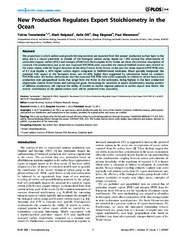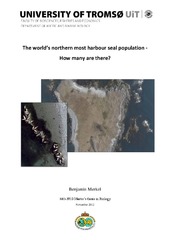Institutt for arktisk og marin biologi: Recent submissions
Now showing items 1821-1840 of 2049
-
The World's Northernmost Harbour Seal Population - How Many Are There?
(Journal article; Tidsskriftartikkel; Peer reviewed, 2013)This study presents the first abundance estimate for the world’s northernmost harbour seal (Phoca vitulina) population, which resides in Svalbard, Norway, based on three digital stereoscopic photographic surveys conducted in 2009 and 2010. The counts from these high resolution 3D images were combined with a novel method for estimating correction factors for animals that were in the water at the ... -
New production regulates export stoichiometry in the ocean
(Journal article; Tidsskriftartikkel; Peer reviewed, 2013)The proportion in which carbon and growth-limiting nutrients are exported from the oceans’ productive surface layer to the deep sea is a crucial parameter in models of the biological carbon pump. Based on .400 vertical flux observations of particulate organic carbon (POC) and nitrogen (PON) from the European Arctic Ocean we show the common assumption of constant C:N stoichiometry not to be met. ... -
Arctic Small Rodents Have Diverse Diets and Flexible Food Selection
(Journal article; Tidsskriftartikkel; Peer reviewed, 2013)The ecology of small rodent food selection is poorly understood, as mammalian herbivore food selection theory has mainly been developed by studying ungulates. Especially, the effect of food availability on food selection in natural habitats where a range of food items are available is unknown. We studied diets and selectivity of grey-sided voles (Myodes rufocanus) and tundra voles (Microtus oeconomus), ... -
Contrasting Population and Life History Responses of a Young Morph-Pair of European Whitefish to the Invasion of a Specialised Coregonid Competitor, Vendace
(Journal article; Tidsskriftartikkel; Peer reviewed, 2013)Invasions of non-native species represent a global problem of great scientific interest. Here we study in detail the response in population and life history characteristics of closely related native species, with divergent habitat preferences, that are impacted by an invading species over a sufficient time period to allow a new stable state to become established. A time series of 20 years starting ... -
Bacterial diversity of aMasi, a South African fermented milk product, determined by clone library and denaturing gradient gel electrophoresis analysis
(Journal article; Tidsskriftartikkel; Peer reviewed, 2013)In the present study, we investigated the bacterial diversity of aMasi, a traditional South African fermented milk product, by 16S rRNA clone library and Denaturing Gradient Gel Electrophoresis (DGGE) analysis. Two hundred and eighty two clones from clone library were isolated and identified from aMasi, prepared from the milk of four cows from one herd in the EkuPindiseni Community, North West of ... -
Homing behaviour of Atlantic salmon (Salmo salar) during final phase of marine migration and river entry
(Journal article; Tidsskriftartikkel; Peer reviewed, 2013)Little is known about Atlantic salmon behaviour during the last phase of the marine homing migration and subsequent river entry. In this study, 56 adult Atlantic salmon in the Alta Fjord in northern Norway were equipped with acoustic transmitters. Salmon generally followed the coastline, but their horizontal distribution was also affected by wind-induced spreading of river water across the fjord. ... -
Biovolume spectrum theories applied: spatial patterns of trophic levels within a mesozooplankton community at the polar front
(Journal article; Tidsskriftartikkel; Peer reviewed, 2010)Three-dimensional data on the mesoscale distribution of hydrography and mesozooplankton were collected at the Polar Front, northwestern Barents Sea, in spring 2008 (29 April 15 May) using a combination of multinet and towed instrument platform equipped with Laser Optical Plankton Counter, fluorometer and CTD. Trophic levels (TLS) within the zooplankton community (whole community and size-separated) ... -
Fjellrev i Finnmark” - Rapport for perioden 2008-2012.
(Research report; Forskningsrapport, 2013)Som et av to prosjekter i en stor nasjonal satsning for å redde den utrydningstruede fjellreven, ble «Fjellrev i Finnmark» startet opp våren 2004. Prosjektet har fra starten av hatt to hovedmålsettinger. 1)Å gjøre grunnleggende forskning på økosystembetingelser som begrenser fjellrevenbestandens nåværende utbredelse og bestandsvekst i Øst-Finnmark spesielt, og i sub- & lav-Arktis generelt, med ... -
How spatial variation in areal extent and configuration of labile vegetation states affect the riparian bird community in Arctic Tundra
(Journal article; Tidsskriftartikkel; Peer reviewed, 2013)The Arctic tundra is currently experiencing an unprecedented combination of climate change, change in grazing pressure by large herbivores and growing human activity. Thickets of tall shrubs represent a conspicuous vegetation state in northern and temperate ecosystems, where it serves important ecological functions, including habitat for wildlife. Thickets are however labile, as tall shrubs respond ... -
Arctic Ecosystem Services : interviews from Norway, Russia, Alaska and Canada
(Conference object; Konferansebidrag, 2013) -
The world's northern most harbour seal population - How many are there?
(Master thesis; Mastergradsoppgave, 2012-11-15)This study presents the first abundance estimate for the world's northernmost harbour seal (Phoca vitulina) population, which resides in Svalbard, Norway, based on three digital stereoscopic photographic surveys conducted in 2009 and 2010. The counts from these high resolution 3D images were combined with a novel method for estimating correction factors for animals that were in the water at the time ... -
Relation between habitat characteristics and abundance, diet and condition of 0-group cod in two northern Norwegian fjords
(Master thesis; Mastergradsoppgave, 2013-05)There is a correlation between the vegetation coverage and the abundance of 0-group cod. The highest abundance was found between 50 – 70 %, which is consistent with previous studied and imply that there is a nonlinear relationship between vegetation coverage and abundance of 0-group cod. There was found a difference in diet between the three habitats, with the intertidal zones of Balsfjord and ... -
Carbon source and trophic structure along a depth gradient in Isfjorden, Svalbard
(Master thesis; Mastergradsoppgave, 2013-08-29)Stable isotope analysis has been used to examine marine food webs since the 1980s and has become a valuable tool for studying carbon sources and trophic structures in benthic food chains in the Arctic. Prior to the present study, no one has used stabile isotope analysis to test for a difference in the main carbon source or trophic structure along a depth gradient in the Arctic. Carbon sources (pelagic ... -
Ernæringsbasert metanproduksjon hos sau
(Master thesis; Mastergradsoppgave, 2013-05-21)Drøvtyggere er plantespisere og avhengig av symbiotisk mikrobiell fordøyelse i vom og baktarm for å kunne utnytte cellulose, hemicellulose og lignin som finnes i plantecelleveggen til plantene. I drøvtyggervomma finnes ulike bakterier, ciliater, anaerob sopp og metanogene arker i høye konsentrasjoner. Metanogenene produserer metan ved at de bruker hydrogen til å redusere karbondioksid (Sirohi et al, ... -
Fine scale haul-out behaviour of harbour seals (Phoca vitulina) at different localities in northern Norway
(Master thesis; Mastergradsoppgave, 2013-05-14)The haul-out behaviour of harbour seal (Phoca vitulina vitulina) is influenced by several factors such as the tidal state and environmental variables. Understanding these effects is important for designing counting-surveys providing data necessary to be able to estimate population size. The haul-out behaviour of harbour seals was investigated during the moulting period in three different localities ... -
Do mothers manipulate grandparental care?
(Master thesis; Mastergradsoppgave, 2013-05-15)Many studies have been done on grandparental investment, asking why grandparents distribute their resources skewered. Maternal grandmothers invest most, and parental grandfathers invest least in their grandchildren. Here resemblance is used as an indicator of kin, asking if grandparents feel their grandchildren resemble them and looking at how they invest in these grandchildren. Daughters do not ... -
Temporal and spatial variation in a high Arctic bedrock macrobenthic community in Hinlopen, Svalbard. A baseline study related to possible climatic change
(Master thesis; Mastergradsoppgave, 2013-08-15)Zonation patterns within a high Arctic, hard bottom community within the Hinlopen Strait, Svalbard were investigated using image analysis of underwater photoquadrates. This long term study consists of depth transects taken over a six year period were on a sublittoral vertical wall permanent monitoring station. Analysis indicated that the depth in which the greatest number of species occurred increased ... -
Terrestrial locomotion in the Svalbard ptarmigan (Lagopus muta hyperborea). How does treadmill running compare with running overground?
(Master thesis; Mastergradsoppgave, 2013-05-16)The Svalbard rock ptarmigan (Lagopus muta hyperborea) is a resident bird on the Svalbard achipelago, living in an environment where it experiences extreme climatic and photoperiodic conditions. The bird’s most striking adaption to this environment is, prior to the onset of winter, its deposition of fat, comprising up to 30% of body mass. Moving around with this excess mass may prove difficult as it ... -
Life history strategies of a trimorphic population of Arctic charr (Salvelinus alpinus (L.)) in Skogsfjordvatn, northern-Norway
(Master thesis; Mastergradsoppgave, 2013-05-15)Polymorphisms are widespread throughout many different taxa of vertebrates. Discrete polymorphisms or morphs usually differentiate in morphology, ecology and life history, most likely driven by adaptations to different habitats and resources. For sympatric morphs to be able to maximize fitness in different niches and habitats, they may develop differences in several life history traits. Arctic charr ... -
No evidence of optimal foraging in chick-raising black-legged kittiwakes (Rissa tridactyla) in the Southern Barents Sea
(Master thesis; Mastergradsoppgave, 2013-05-21)The black-legged kittiwake (Rissa Tridactyla) situation is getting more serious as the population numbers have declined over the last decades, and this well-known species is now considered endangered (EN) in the Norwegian redlist 2010. This study investigates the differences between adult and chick diet considering prey selection to be an important point. Earlier chick diet has been considered a ...


 English
English norsk
norsk


















